« Diving the Revillagigedos (Socorro): Mantas! | Main | Battery frustrations »
September 5, 2011
Whale sharks in the wild
Whale sharks are filter feeders and the largest living fish in the ocean. They can be over 40 feet in length, weigh almost 40 tons, and go back some 60 million years. They pose no danger to divers, and they can be observed as they are slow swimmers. And I wanted to see them.
After a good deal of cursing the airlines for their ever more infuriating pricing and scheduling practices we did come across a reasonable deal: eight days at the Riu Palace Las Americas hotel and resort in Cancun. Now Cancun is not exactly known for diving, but it is close to Isla Mujeres, which is where the whale sharks are, at least through about mid-September. Perusing the ScubaBoard.com discussion website yielded a gamut of opinions, but it did seem that Cancun dive sites had lots of fish, and there are plenty of outfits that take you diving and on whale shark tours.
The name Scorpio Divers popped up often, but after reading hundreds of posts we were still not clear how hotel pick-up and drop-off worked in Cancun scuba diving, what with all the gear, being wet, etc. In addition, I do like to have a home base on the premises where we can leave our gear. So after I found that the Riu had a PADI 5-Star shop on location and you could book dives in advance for a discount, that seemed the reasonable approach.
That left the whale shark tour, and after all the praise they had gotten, I did send the Scorpio Diver guys an email and inquired about their tours. Much to their credit, Jorge, one of Scorpio's principals, responded virtually right away, answered all my questions, and the price seemed right. And they would pick us up at the hotel and drop us off there. So we struck a deal for a door-to-door whale shark tour for the third day of our trip.
We agonized over what to bring along, then made sure we were at the front of the hotel five minutes before the pickup window. 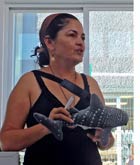 A van picked us up and brought us to a terminal at Puerto Juarez a bit north of Cancun on the mainland where a good number of people either had prepaid or had one sort of voucher or confirmation or other. There was a briefing where we learned that Cancun was one of only two places in the world where whale sharks come to the surface. And that boats cannot be longer than 33 feet, and that there are only so and so many licenses. Martha of Caribbean Connection, the outfit that actually seemed to own or at least control the boats, cautioned that the plankton the whale sharks eat moves with weather and storms. There is a vast area on the open ocean where the whale sharks could be, so it might take a while to find them.
A van picked us up and brought us to a terminal at Puerto Juarez a bit north of Cancun on the mainland where a good number of people either had prepaid or had one sort of voucher or confirmation or other. There was a briefing where we learned that Cancun was one of only two places in the world where whale sharks come to the surface. And that boats cannot be longer than 33 feet, and that there are only so and so many licenses. Martha of Caribbean Connection, the outfit that actually seemed to own or at least control the boats, cautioned that the plankton the whale sharks eat moves with weather and storms. There is a vast area on the open ocean where the whale sharks could be, so it might take a while to find them.
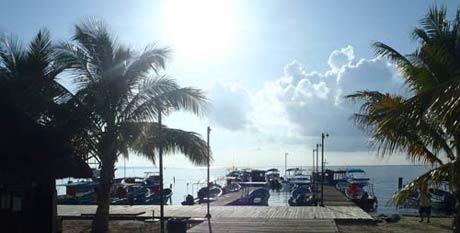
Eventually we were assigned to one of the boats that held 10 people, had a sun cover, and two big Mercury outboard engines. The water was calm and only got a bit rougher after we passed Isla Mujeres. The ride was perhaps an hour until in the distance we spied a number of similar boats, all assembled in a fairly small area. When we got there it was obvious that we had hit the whale shark jackpot. There were several dozens and perhaps over a hundred, and snorkelers from perhaps 40 boats. The way it worked was that two snorkelers per boat were supposed to be in the water at the same time along with a guide.
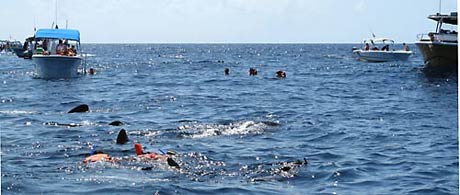
It was all quite overwhelming. The whale sharks surfaced to scoop up food, then swam just under the surface. Carol and I got in in our wetsuits, and so were not required to wear a life jacket. We were the only ones on the boat who had brought our own equipment. Just as we were ready to go in Carol's snorkel broke and she had to use one from the boat.
In the water, watching the whale sharks was a bit like a manatee encounter in Crystal River, only the whale sharks move faster, they are much bigger, and this was in the open ocean. Whale sharks do not shy away from people, but also do not seem to have the curiosity in people that mantas have. It was stunning and amazing to be right on top or alongside one of those huge creatures.
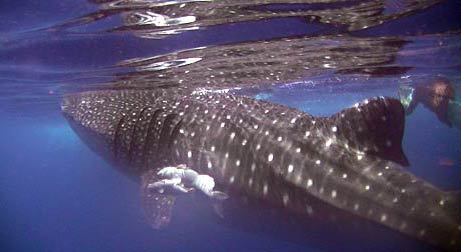
The two snorkelers at a time rule first seemed a nuisance, but it worked out fine as some got in less than others. The seas were a little choppy and four of the ten people on our boat got seasick. I had taken a precautionary Bonine before the trip and was fine. I felt bad for those affected, but it also meant that Carol and I had more snorkel time.
We were the last boat leaving for the ride back. Interestingly, we saw numerous yellow butterflies on the water, many miles from shore. Where were they going?
We stopped by the northern tip of Isla Mujeres for some relaxing snorkeling in a shallow reef, then stopped for half an hour on a beach nearby with perhaps the whitest sand and bluest water I have ever seen. In fact, much of the water between Mujeres and the mainland seems that way, just all bright blue-green due to the white sand at the bottom and nothing else.
At the pier, our return transportation was fairly well arranged, and we were back at the Riu around 3:30. Later in the day I received an email from Jorge at Scorpio, asking how it'd gone, and said he'd seen me boarding with my diver crocs. I did wear diver crocs. Amazing. The experience had been such that Carol and I both wanted to go back. Jorge was glad to comply, with an extra discount for repeat customers.
So on the last day of the trip we went back to the whale sharks. This time we knew the drill, which always makes things easier. There were fewer people and the staff actually recognized us and was absolutely thrilled to have us back, going as far as announcing it to the assembly of waiting customers.
Fewer people meant less confusion over who went where, and so we found ourselves on the boat much quicker. On the way we posed for a group picture with a local dressed up in what seemed Mayan warrior gear, then boarded the vessel, which was of a different design and newer than the one we had been on prior. This one even had a toilet on board, and that always comes in handy.
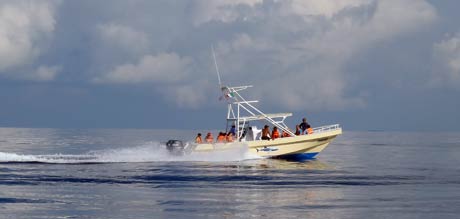
The weather was perfect, the water all flat, even past Isla Mujeres, and so the roughly one hour ride was pleasant for all onboard. No sea sickness this time. When the whale shark boats appeared on the horizon, it was quickly apparent that they were much more spread out and there were fewer, perhaps 25 versus 40+ on Monday. This first concerned me, but it turned out to be a good thing.
This time we did not to bring our own gear except our masks and snorkels. This meant a much smaller gear bag with just the essentials: cameras, wetsuit pants and tops, bio-degradable sunscreen, towels, whatever money we needed, and that was that. The boat had fins that fit quite well, and they actually worked well enough that I am considering adding a pair of full-foot fins to my gear.
Not having to wear a life vest is a big advantage as the bulk of the vest slows you down when swimming and also makes it difficult to put your head underwater. You're much better off with a wetsuit. Even though I had just thin wetsuit pants and a black long-sleeved Liquid Image shirt, that provided still enough buoyancy in the salty water to keep me afloat and comfortable.
Though there were fewer whale sharks and we sometimes had to look and wait for one or two, this meant fewer snorkelers swimming with the animals. At times we had a whale shark all to ourselves, making for an entirely different experience than being in the midst of a thrashing group of snorkelers with fins swirling up the water and making it hard to see anything.
The water was so flat and clear and the sun so bright that we truly could not have wished for better conditions. The whale sharks appeared mostly solo but sometimes in pairs. We also saw a baby calmly scooping up food and apparently unperturbed that a parent was not close-by. Baby is relative here as it was still a good 12 feet long.
Whale sharks are calm and placid creatures. They move at a slow and fairly predictable pace and are not given to sudden changes or erratic movement. For the most part they idle along at a pace that made it possible for snorkelers to keep up with them for a while. If you finned hard you could actually catch up or pass one, seeing its head and mouth. The sharks stayed fairly shallow the entire time, maybe five or six feet at the most. For feeding they slightly angled their body so that their mouth was higher and often at the surface.
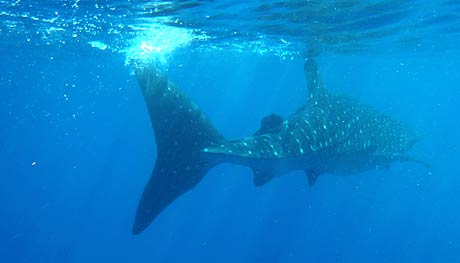
Whale sharks move by winding themselves through the water, powered by slow sideways movement of their large tail fin. They have massive gills and all have what at first sight looks like the same appearance: gray with lighter color dots. Their eyes are very small for creatures this size, and they sit just ahead of what appears to be ears, which you first mistake for eyes. Unlike sharks that almost always bear marks and scars, most of the whale sharks we saw were in pristine condition without any scars or blemishes.
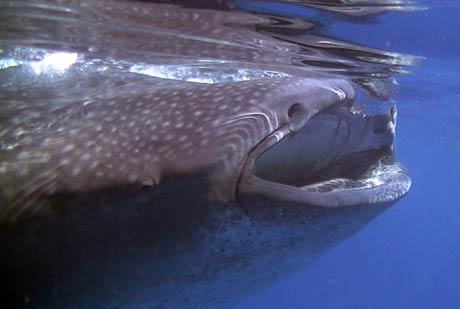
Whale sharks don't seem to be either drawn to nor afraid of humans. They don't shy away, but also don't barrel into a snorkeler in their path. They seem able to control their path and bodies so that even when they are close, there is never any contact. In that way they are very much like fish that are almost impossible to touch.
With wetsuits on and as videotaping divers, the captain gave us permission to be in the water whenever and for as long as we wanted when he easily could have insisted on the strict two snorkelers rule. This gave Carol the opportunity to stay in the water the entire two hours we were there, and me the freedom to jump in and get back on the boat however I wanted.
We had an interesting combination of people on the boat. There were four young German women, a Dutch couple, a Hispanic couple, a lady from Oklahoma, and us. The Dutch woman said she was only afraid of three things in life: spiders, fish larger than herself, and being in a deep ocean. Despite that, she managed to go in and be thrilled, as did the woman from Oklahoma who was new to snorkeling and the ocean. The German girls were absolutely beside themselves over the experience, and Carol and I were blown away all over again as well.
This time we, having learned from our mistakes the first time, only took one camera at a time. We had also adjusted our camera settings and the result was much better pictures and video. It is still not easy as the whale sharks do not pose, but we got some great footage.
All too soon we went back, stopped at the reef at the north side of Isla Mujeres, but not the white sand beach, and then back to port. We then got to talk to Martha who gave us some background info. We learned that they are in contact with the Georgia Aquarium and actually will visit there. It's a small community of people in love with whale sharks, and they all seem to know each other.
Posted by conradb212 at September 5, 2011 2:23 AM








